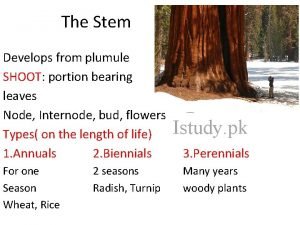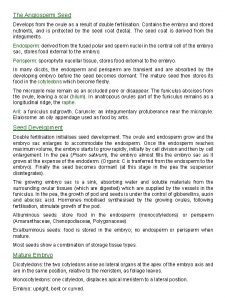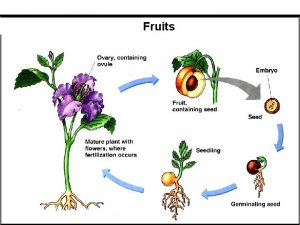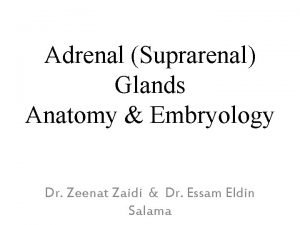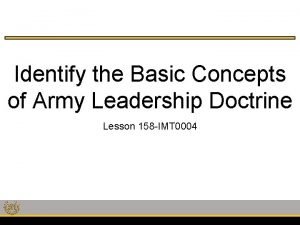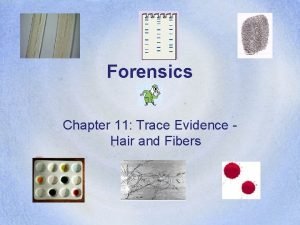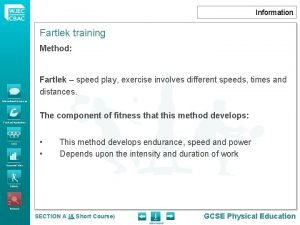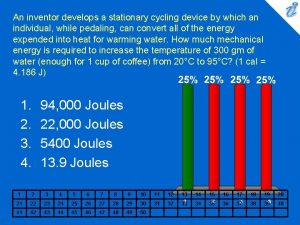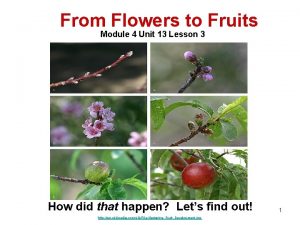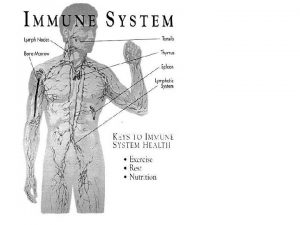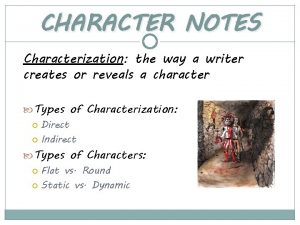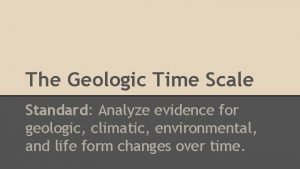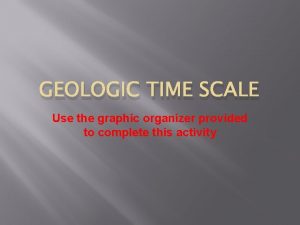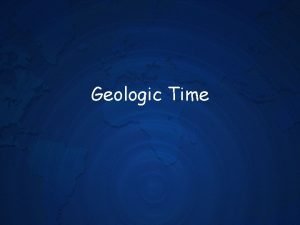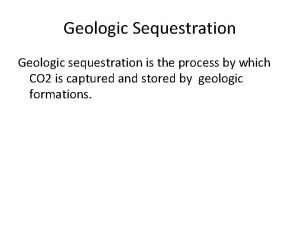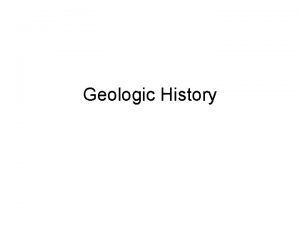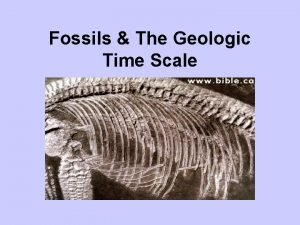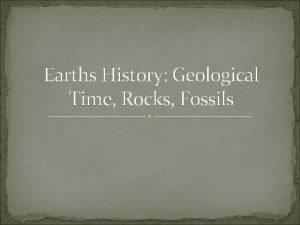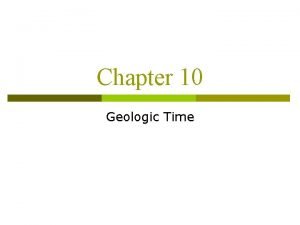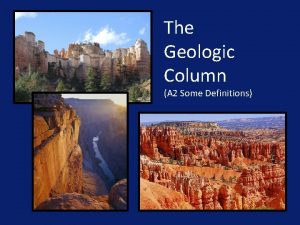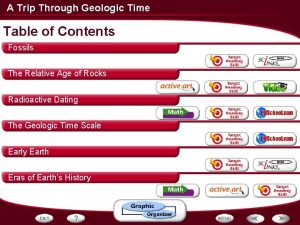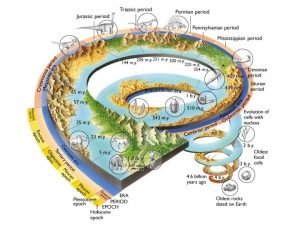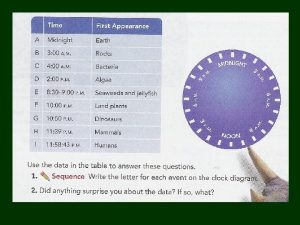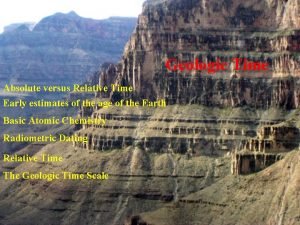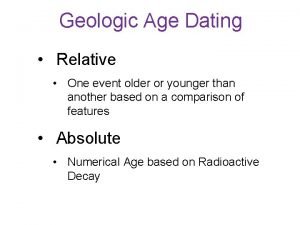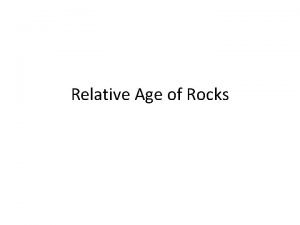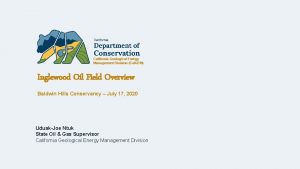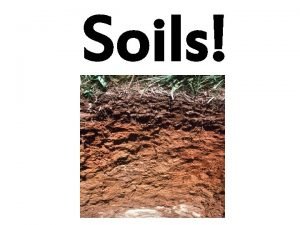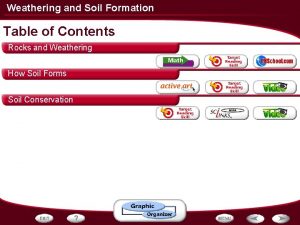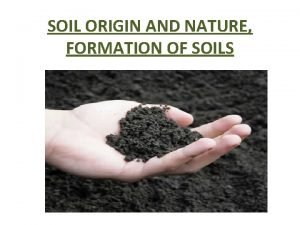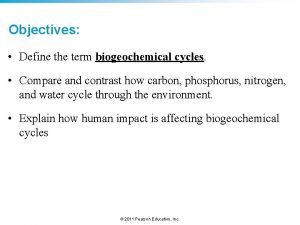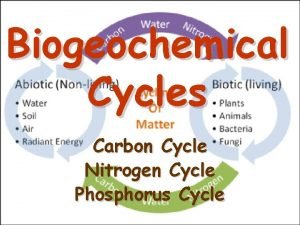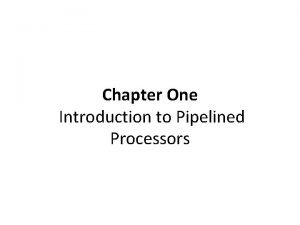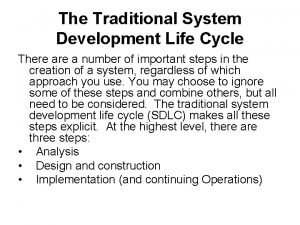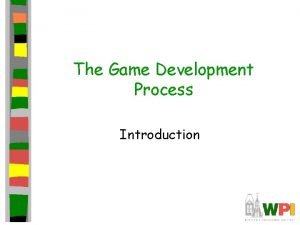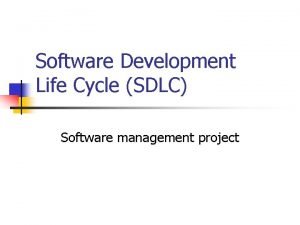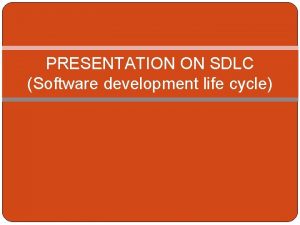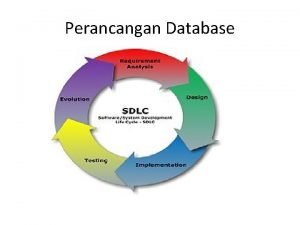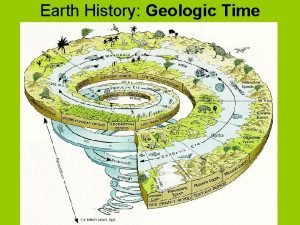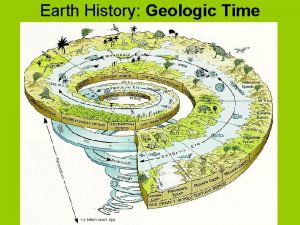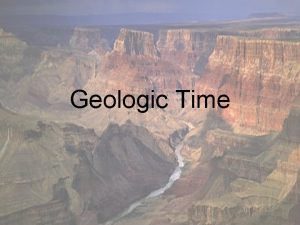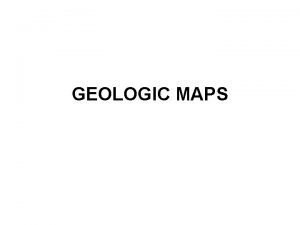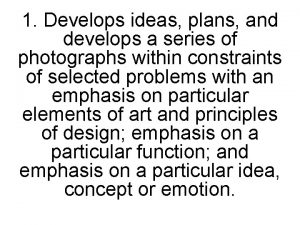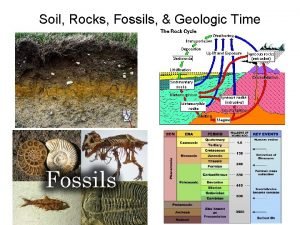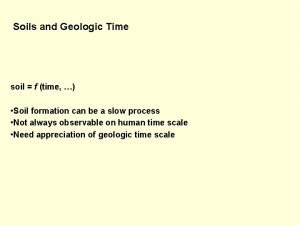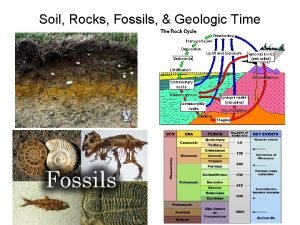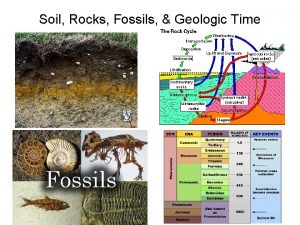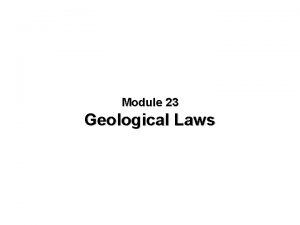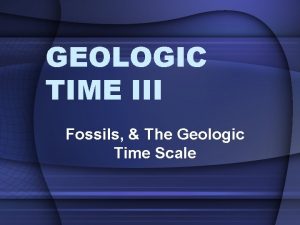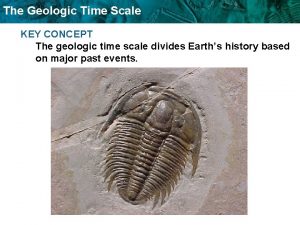SOIL POWERPOINT SOIL DEVELOPMENT GEOLOGIC CYCLE Soil develops






































































- Slides: 70

SOIL POWERPOINT

SOIL DEVELOPMENT • GEOLOGIC CYCLE – Soil develops relatively quickly in terms of geologic time – Soil forms at different rates in the three kinds of rock: • igneous • sedimentary • metamorphic

SOIL INTRODUCTION • GEOLOGIC CYCLE – The mineral component of the soil was once part of the molten liquid at the earth’s core – As the earth cooled, its surface hardened into solid rock – Outcrops of this cooled, hardened molten rock, known as igneous rock, are found in southeastern Pennsylvania

SOIL INTRODUCTION • GEOLOGIC CYCLE – Exposed to the assaults of weather and time, solid rock slowly and continually crumbles and disintegrates – This weathering process produces the unconsolidated mineral material in which soil forms – On stable landscape, soil develops and matures in this material directly above the weathering rock – On an eroding terrain, it is carried away by water and eventually flows into the sea

SOIL INNTRODUCTION • GEOLOGIC CYCLE – Water sorts transported particles by size, separating sand, silt, and clay – Clay deposits become shale, silt becomes siltstone, and sand becomes sandstone – Eventually in geologic time what was once the sea bottom – rises and becomes the sedimentary rock of dry land

SOIL INTRODUCTION • GEOLOGIC CYCLE – Exposed at the earth’s surface, sedimentary rock weathers anew – Deep within the earth, great heat and pressure further harden and change it into metamorphic rock

SOIL INTRODUCTION • GEOLOGIC CYCLE – When geologic events bring metamorphic rock to the surface, it too will slowly weather, form soil materials, erode away, and eventually form rock again – THE CYCLE CONTINUES. . FOREVER….

SOIL • WEATHERING – Soil formation starts with weathering • Bare Rock • Buried Rock – Several factors bring about weathering • Temperature fluctuation, which causes expansion and contraction • Erosion by water, wind, and ice

SOIL • WEATHERING CONTINUED: – Factors that contribute to weathering: • Plant roots growing into tiny cracks, causing them to spread • Chemical reactions of soil minerals with water and air

SOIL • COMPOSITION – in the transformation of rock to soil, minerals undergo so many changes that the soil minerals, although remaining representative of the original rock minerals, usually change their composition

Soil • COMPOSITION – More than just weathered rock • Organic Matter – decomposing and decomposed parts of animal and plant material – multitude of soil organisms, mostly microscopic. – The microorganisms contribute to the weathering of minerals and the breakdown of organic residues

SOIL • COMPOSITION – Parent Material: The medium in which soil develops – This material is usually weathered rock in Pennsylvania, but in bogs and marshes it is decayed organic matter – Parent material – may also be loose material, gravel, for example, deposited along rivers and streams during floods

SOIL • Parent Material – Within the parent material processes such as leaching and redistribution of minerals take place – These processes result in the differentiation of horizons below the surface

SOIL • HORIZONS – A Horizon: Topsoil, has the most organic matter and is the root zone – B horizon: Subsoil layer contains higher concentrations of clay and is denser than the A horizon – C Horizon: the parent material — the altered organic deposit or the weathered bedrock – R Horizon: Bedrock is the last layer – The depth and thickness of the horizons vary with each soil

SOIL • VEGETATION – Vegetation will begin when soil is in place for a long time – The kind of vegetation growing affects the soil below – grasses give topsoil a well aerated, crumbly structure and high levels of organic matter – Trees contribute organic matter largely through the annual falling of leaves rather than through their root systems – forest soils tend to have low level of organic matter within the soil

SOIL • VEGETATION – Not only does vegetation contribute to soil development, it also reveals much about soil conditions – many species require particular ranges of soil moisture, texture, and acidity (p. H)

SOIL • CLIMATE AND TIME – Climate is a major influence on the rate of soil development – Pennsylvania has a humid climate, with an annual rainfall ranging from 34 to 50 inches – Rainwater slowly breaks down minerals causing soil to be less fertile and more acidic

SOIL • CLIMATE AND TIME – Rain also very slowly carries down from the topsoil the smallest soil particles, the fine clays – Heat, as well as rainfall, accelerates the process of soil development – PA soil has greater maturity — pedologic age — than that of the same initial parent material developing in the Arctic for the same length of time.

SOIL • PA SOIL FORMATION – Factors include: • Weathering • Vegetation • climate and time working on the particular parent material and topography of the region

SOIL • PA SOIL – Many different types of bedrock underlie Pennsylvania • Southeastern and Northwestern edges were derived from sand • Southeastern part of PA derived from metamorphic rock: chist, gneiss, and quartzite — is the oldest outcrop in the state and some siltstone and igneous rock • Rest of PA is sedimentary rock — shale, • sandstone, and limestone

SOIL • PA SOILS – Sandstone, the hardest and most chemically resistant sedimentary rock, forms the ridge caps – Limestone, the least resistant, forms the valleys – Shale, of intermediate resistance, underlies the slopes

SOIL • Sandstone soils: tend to be coarse, dry out so fast that they do not support many crops • Limestone soils: in the valleys are generally fertile and productive — the. best agricultural soils in Pennsylvania • Shale soils: are fine textured and tend to be acidic and low in nutrients — with large additions of fertilizer, they are farmed

SOIL • STRIP MINING: – Much of the land overlying shale deposits has been ruined by strip mining, because shale contains Pennsylvania’s rich coal beds. Strip mining removes all the rock and soil material above the coal, and then backfills the depleted mine with crushed rock, called mine spoil. Because the soil surface is gone, almost nothing grows on the mine spoil, leaving a barren wasteland which erodes and clogs up streams.

SOIL • Strip Mining: – More acreage has been disturbed by strip mining in Pennsylvania than in any other state – 1971 legislation in PA to replace topsoil layer

SOIL • Residual: soils that have formed over time in a particular location – Definition: unconsolidated and partly weathered mineral materials accumulated by disintegration of rock in place • Transported: Soil not formed where it is located – Definition: The forces of ice, water, wind, and gravity carry small particles as well as rocks across the landscape. Soil forms in this transported material deposited over the original soil or bedrock

SOIL • TRANSPORTED SOILS: – Glacial: not well suited to row-crop agriculture, but make good pasture and hay land – Aeolian: created some of the richest agricultural soil on earth (not found much in PA) also called Loess – Colluvial: Because colluvial soils have a problematic feature called fragipans, they are often used for pastures rather than for development – Alluvial: good for farming, are generally hazardous for building because they are subject to flooding.

SOIL • SOIL PROPERTIES – Texture: Particle-size distribution • determines how readily air and water will pass through, be held, or be blocked by the soil • Soil texture can be felt by rubbing the soil between the thumb and fingers • The terms sand, silt, and clay refer only to size, not to the chemical makeup of the particles

SOIL • SOIL PROPERTIES – Active Fractions • Clay and organic matter – Soil Water • Moisture and texture determine soil strength or consistency • The balance between particle size and water content is critical both for engineering and agricultural uses of soil • Drainage conditions are often indicated by soil color

SOIL • SOIL PROPERTIES – Soil Ph: • A soil p. H of 6. 5 is optimal for most crops • Pennsylvania soils usually have a lower, or more acidic, p. H because the abundant rainfall leaches out alkaline ions • Rainfall decreases from East to West in the US

SOIL • CLASSIFYING SOIL – Soil Series: • orders, suborders, great groups, subgroups, and families • Pedological age, temperature and water regimes, and special features such as fragipans, are some of the characteristics on which the system is based

SOIL • COUNTY SOIL SURVEYS – Soil surveys contain valuable data about local soils, including maps, yield potentials for each soil series, limitations for development, and detailed soilidentifying features. Surveys for most counties in Pennsylvania have been completed and are available. You can get one by requesting it from your county agent, your representative in Congress, or your local office of the Soil Conservation Service. Soil surveys for every county in Pennsylvania will be available by 1989

SOIL CONCERNS • EROSION – Wind or water erosion is the physical wearing of the earth’s surface. Surface soil material is removed in the process. – TWO TYPES • WIND • WATER

SOIL CONCERNS • EROSION SIGNS: – WIND • dust clouds • soil accumulation along fence lines or snow banks • a drifted appearance of the soil surface – WATER • • small rills and channels on the soil surface soil deposited at the base of slopes sediment in streams, lakes, and reservoirs pedestals of soil supporting pebbles and plant material

SOIL CONCERNS • How can soil erosion be avoided? – Soil erosion can be avoided by: • maintaining a protective cover on the soil, • creating a barrier to the erosive agent, • modifying the landscape to control runoff amounts and rates

SOIL • Specific practices to avoid water erosion: • growing forage crops in rotation or as permanent cover • growing winter cover crops • interseeding • protecting the surface with crop residue • shortening the length and steepness of slopes • increasing water infiltration rates • improving aggregate stability

SOIL CONCERNS • • Specific practices to avoid wind erosion: maintaining a cover of plants or residue planting shelterbelts Strip-cropping increase surface roughness cultivating on the contour maintaining soil aggregates at a size less likely to be carried by wind

SOIL CONCERNS • SEDIMENT DEPOSITION – Sediment is solid material that is or has been transported from its site of origin by air, water, gravity, or ice to a field or low landscape position. Deposition occurs when the amount of sediment becomes greater than the carrying capacity of the force that is moving it.

SOIL CONCERNS COMPACTION – Soil compaction occurs when soil particles are pressed together, reducing the pore space between them. This increases the weight of solids per unit volume of soil (bulk density). Soil compaction occurs in response to pressure (weight per unit area) exerted by field machinery or animals. The risk for compaction is greatest when soils are wet

SOIL CONCENRS • COMPACTION – Why is compaction a problem? • Compaction restricts rooting depth, which reduces the uptake of water and nutrients by plants • It decreases pore size, increases the proportion of water-filled pore space at field moisture, and decreases soil temperature • Decreases the rate of decomposition of soil organic matter and subsequent release of nutrients • Compaction decreases infiltration and thus increases runoff and the hazard of water erosion.

SOIL CONCERNS • Salinization – Salinization is the process by which watersoluble salts accumulate in the soil. Salinization is a resource concern because excess salts hinder the growth of crops by limiting their ability to take up water. Salinization may occur naturally or because of conditions resulting from management practices.

SOIL CONCERNS • SALINIZATION – Processes that may affect salt level in soil • • • hydrology climate irrigation drainage plant cover and rooting characteristics farming practices

SOIL CONCERNS • What are some indicators of soil salinity? – Early signs: • increased soil wetness in semiarid and arid areas to the point that the soil does not support equipment • the growth of salt-tolerant weeds • irregular patterns of crop growth and lack of plant vigor

SOIL CONCERNS • • SALINIZATION Advanced signs: white crusting on the surface a broken ring pattern of salts adjacent to a body of water • white spots and streaks in the soil, even where no surface crusting is visible • the presence of naturally growing, salt-tolerant vegetation

SOIL CONCERNS • How can salinity problems be managed? • Reducing the severity and extent of soil salinity is primarily a problem of water management. Water management can be addressed in two ways: (1) by managing the area contributing excess water to the soil (recharge area) or (2) by managing the area where the excess water comes to the surface (discharge area).

SOIL CONCERNS • SOIL BIODIVERSITY – Soil biodiversity reflects the mix of living organisms in the soil. These organisms interact with one another and with plants and small animals forming a web of biological activity.

SOIL CONCERNS • SOIL BIODIVERSITY – What are the benefits of soil organisms? • Residue decomposition • Nutrient cycling – Management considerations • • • Cultivation Crop Rotation Compaction Pest Control Fertility Crop Residue Management

SOIL CONCERNS • Available Water Capacity – the amount of water that a soil can store that is available for use by plants – Soil properties affect available water • • • Rock fragments Organic Matter Bulk Density Osmotic Pressure Texture

SOIL CONCERNS • Improving the available water – Apply organic matter to the surface or mix into the upper few inches to increase the available water fraction near the surface – Maintain salts below the root zone. Keep infiltration high, reduce evaporation with a residue cover, minimize tillage, avoid mixing the lower soil layers with the surface, and plant seeds and seedlings on the furrow edges – Minimize compaction by reducing the weight of vehicles and the amount of traffic

SOIL CONCERNS • PESTICIDES – synthetic organic chemicals used to control weeds in fields and lawns, and unwanted or harmful pests, such as insects and mites that feed on crops. Pesticides are divided into categories according to the target organisms they are designed to control

SOIL CONCERNS • TYPES OF PESTICIDES – Herbicides: specific weeds in specific crops – Insecticides: Insect pests – Fungicides: fungi

SOIL CONCERNS • • • • Use and application considerations Apply pesticides at the lowest effective level. Avoid unnecessary pesticide treatments. Use Integrated Pest Management. Follow all label instructions. Apply proper rates and times as label indicates. Calibrate application equipment. Apply formulations that minimize drift. Use safety equipment when handling. Store and dispose of pesticide containers properly. Use biological controls when appropriate. Alter farming or cropping systems to control pests. Use disease and insect resistant crop varieties.

SOIL CONCERNS • Hydrophobicity – Soils that repel water are considered hydrophobic – Why is Hydrophobicity important? • Fire-induced water repellency can affect soil and the watershed

SOIL CONCERNS • What affects the development of hydrophobic layers? – Not all wildfires create a water-repellent layer. Four factors commonly influence the formation of this layer. These include: – A thick layer of plant litter prior to the fire – High-intensity surface and crown fires – Prolonged periods of intense heat – Coarse textured soils

SOIL CONCERNS • Treatment • Place fallen logs across the slope to slow run of water and intercept sediment. • On level or gentle slopes, rake or hoe the upper few inches of the soil to break up the water-repellant layer and thus allow water to penetrate the soil for seed germination and root growth. • On gentle and steep slopes, scatter straw mulch to protect the soil from erosion. Anchor the straw to hold it in place. • Other practices that control erosion and reduce runoff include seeding, straw bale check dams, and silt fences.

SOIL QUALITY INDICATORS • • • Organic Matter Soil Crusts Aggregate Stability Infiltration Soil Ph

SOIL QUALITY INDICATORS • Organic Matter – Soil organic matter is that fraction of the soil composed of anything that once lived – In most soils, the organic matter accounts for less than about 5% of the volume – Well-decomposed organic matter forms humus, a dark brown, porous, spongy material that has a pleasant, earthy smell

SOIL QUALITY INDICATORS • Organic Matter – Practices decreasing soil organic matter include those that: 1. Decrease the production of plant materials by - replacing perennial vegetation with short-season vegetation - replacing mixed vegetation with monoculture crops - introducing more aggressive but less productive species - using cultivars with high harvest indices - increasing the use of bare fallow

SOIL QUALITY INDICATORS • Organic Matter – Practices decreasing soil organic matter include those that: 2. Decrease the supply of organic materials by - burning forest, range, or crop residue - grazing - removing plant products

SOIL QUALITY INDICATORS • Organic Matter – Practices decreasing soil organic matter include those that: 3. Increase decomposition by - tillage - drainage - fertilization (especially with nitrogen)

SOIL QUALITY INDICATORS • Practices increasing soil organic matter include those that: – 1. Increase the production of plant materials by - irrigation - fertilization to increase plant biomass production - use of cover crops - improved vegetative stands - introduction of plants that produce more biomass - reforestation - restoration of grasslands

SOIL QUALITY INDICATORS • Practices increasing soil organic matter include those that: 2. Increase supply of organic materials by - protecting from fire - using forage by grazing rather than by harvesting - controlling insects and rodents - applying animal manure or other carbon-rich wastes - applying plant materials from other areas

SOIL QUALITY INDICATORS • Practices increasing soil organic matter include those that: 3. Decrease decomposition by - reducing or eliminating tillage - keeping the soil saturated with water (although this may cause other problems) - keeping the soil cool with vegetative cover

SOIL QUALITY INDICATORS • SOIL CRUSTS – Crusts reduce infiltration and increase runoff. – Crusts restrict seedling emergence – Crusts reduce oxygen diffusion to seedlings – Crusts reduce surface water evaporation – Crusts affect wind erosion

SOIL QUALITY INDICATORS • SOIL CRUSTS – How can the problem be corrected? - Maintain plant cover or crop residues on the soil surface to reduce the impact of raindrops - Adopt management practices that increase aggregate stability - Use practices that increase soil organic matter content or reduce concentrations of sodium ions - Use a rotary hoe or row cultivator to shatter crusts and thus increase seedling emergence and weed control - Employ sprinkler water to reduce restriction of seedling emergence

SOIL QUALITY INDICATORS • Aggregate Stabiltiy – What is aggregate stability? • Aggregate stability refers to the ability of soil aggregates to resist disruption when outside forces (usually associated with water) are applied

SOIL QUALITY INDICATORS • What are soil aggregates? • Soil aggregates are groups of soil particles that bind to each other more strongly than to adjacent particles. The space between the aggregates provide pore space for retention and exchange of air and water.

SOIL QUALITY INDICATORS • Why is aggregate stability important? • Aggregation affects erosion, movement of water, and plant root growth. Desirable aggregates are stable against rainfall and water movement. Aggregates that break down in water or fall apart when struck by raindrops release individual soil particles that can seal the soil surface and clog pores. This breakdown creates crusts that close pores and other pathways for water and air entry into a soil and also restrict emergence of seedlings from a soil.

SOIL QUALITY INDICATORS • Infiltration- the process of water entering the soil • Why is infiltration a concern? – If water infiltration is restricted or blocked, water does not enter the soil, and it either ponds on the surface or runs off the land. Thus, less water is stored in the soil profile for use by plants. Runoff can carry soil particles and surface applied fertilizers and pesticides off the field. These materials can end up in streams and lakes or in other places where they are not wanted.

SOIL QUALITY INDICATORS • What factors influence infiltration? – Texture – Crust – Compaction – Aggregation and Structure – Water Content – Frozen Surface – Organic Matter – Pores

SOIL QUALITY INDICATORS • Ph – Soil p. H is a measure of the acidity or alkalinity in the soil. It is also called soil reaction. – The most common classes of soil p. H are: • Extremely acid 3. 5 – 4. 4 • Very strongly acid 4. 5 – 5. 0 • Strongly acid 5. 1 – 5. 5 • Moderately acid 5. 6 – 6. 0 • Slightly acid 6. 1 – 6. 5 • Neutral 6. 6 – 7. 3 • Slightly alkaline 7. 4 – 7. 8 • Moderately alkaline 7. 9 – 8. 4 • Strongly alkaline 8. 5 – 9. 0
 Compare geologic time with the geologic column.
Compare geologic time with the geologic column. Stem develops from
Stem develops from Testa of seed develops from
Testa of seed develops from Fruit develops from ovary
Fruit develops from ovary Soviet union develops atomic bomb
Soviet union develops atomic bomb Steps in developing multimedia project
Steps in developing multimedia project Adrenal cortex develops from
Adrenal cortex develops from Leadership attributes army
Leadership attributes army Hair proceeds through stages as it develops
Hair proceeds through stages as it develops Develops products for distribution from raw goods
Develops products for distribution from raw goods Fartlek training method diagram
Fartlek training method diagram Prologue section 3 democracy develops in england
Prologue section 3 democracy develops in england Prologue section 3 democracy develops in england
Prologue section 3 democracy develops in england An inventor develops a stationary cycling device
An inventor develops a stationary cycling device Apa itu pericarp
Apa itu pericarp Two types of wbc
Two types of wbc Professor emeritus keith l. moore
Professor emeritus keith l. moore An organism develops active immunity as a result of
An organism develops active immunity as a result of Suppose the acme drug company develops
Suppose the acme drug company develops Round character in cinderella
Round character in cinderella How is the geologic time scale organized
How is the geologic time scale organized Graphic organizer of geologic time scale
Graphic organizer of geologic time scale Geologic time calendar
Geologic time calendar Caprock
Caprock Geologic history meaning
Geologic history meaning Geologic time scale animals
Geologic time scale animals Fossils
Fossils The longest subdivision of the geologic time scale is the
The longest subdivision of the geologic time scale is the Geologic column definition
Geologic column definition Geologic time
Geologic time Eon division
Eon division Geologic time scale drawing
Geologic time scale drawing Pilot knob volcano
Pilot knob volcano Geologic time scale
Geologic time scale Geologic time
Geologic time Geologic time scale
Geologic time scale Principle of superposition
Principle of superposition Geologic history
Geologic history Amantz
Amantz Marli miller
Marli miller Silurian period
Silurian period Geologic layers of earth
Geologic layers of earth What is the longest subdivision in geologic time
What is the longest subdivision in geologic time 4 zoic eras
4 zoic eras Chapter 12 geologic time
Chapter 12 geologic time Cal gem
Cal gem Living soil vs dead soil
Living soil vs dead soil Living soil vs dead soil
Living soil vs dead soil Donald super career development theory powerpoint
Donald super career development theory powerpoint Gcse child development revision powerpoint
Gcse child development revision powerpoint How does soil link the rock cycle and biosphere
How does soil link the rock cycle and biosphere Magnesium cycle
Magnesium cycle Stages of soil development
Stages of soil development Decomposition weathering
Decomposition weathering Brainpop water cycle
Brainpop water cycle Significance of biogeochemical cycle
Significance of biogeochemical cycle Difference between phosphorus cycle and carbon cycle
Difference between phosphorus cycle and carbon cycle Difference between open cycle and closed cycle gas turbine
Difference between open cycle and closed cycle gas turbine Reservation table in computer architecture
Reservation table in computer architecture Chapter 5 two-cycle and four-cycle engines answers
Chapter 5 two-cycle and four-cycle engines answers Grille évaluation handball cycle 3
Grille évaluation handball cycle 3 Disadvantages of mhd generator
Disadvantages of mhd generator Cycle de consolidation
Cycle de consolidation Cycle 3 cycle de consolidation
Cycle 3 cycle de consolidation Water cycle the hydrologic cycle
Water cycle the hydrologic cycle Traditional system development life cycle
Traditional system development life cycle Stages of game development
Stages of game development Sdlc
Sdlc Product life cycle kotler
Product life cycle kotler Software development life cycle ppt
Software development life cycle ppt Requirement collection and analysis
Requirement collection and analysis

